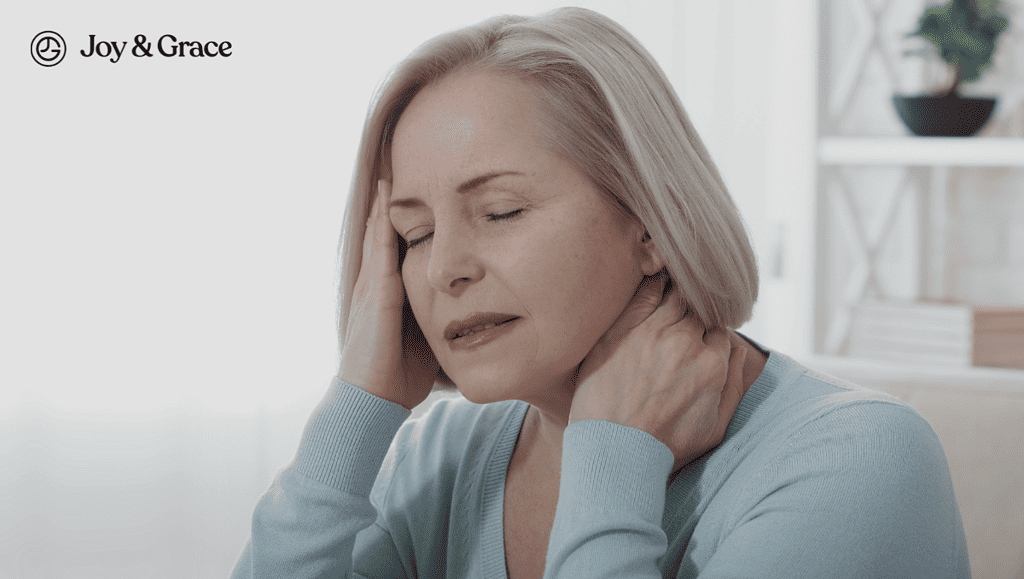Most of us deal with neck pain; that is no secret. The everyday routine of computers and phones puts severe stress on our necks (and our minds, too). But could this daily routine cause our vertebrae to degenerate in the neck, narrow the spaces in our spine, and cause all sorts of problems? Well, unfortunately, it can. Here’s everything you need to know about spinal stenosis in the neck.
What Is Spinal Stenosis?
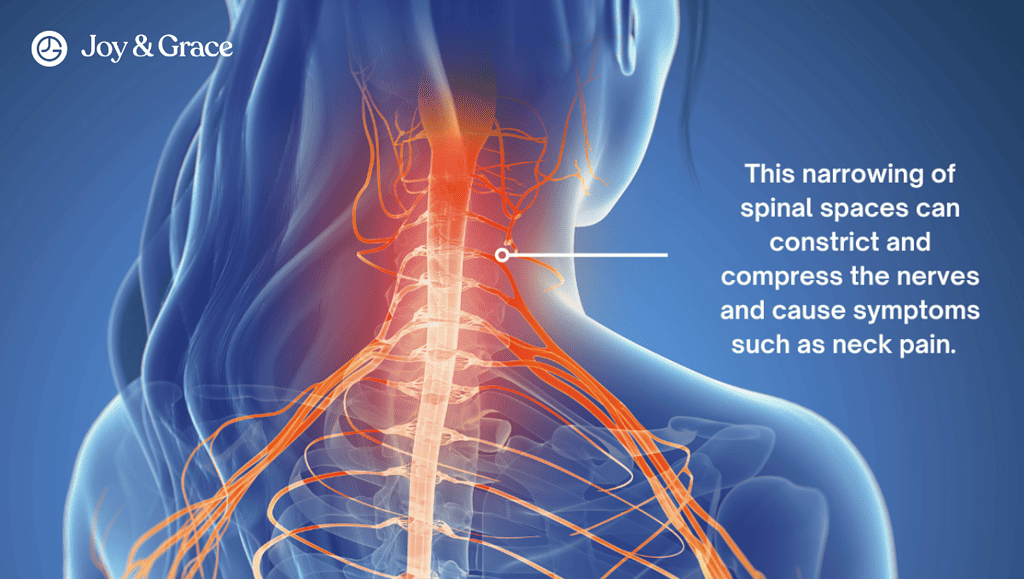
The word “stenosis” originates from the Greek word “stenos,” which means “narrowing.” Thus, spinal stenosis is a condition in which the spaces in the spine become smaller (narrower). This narrowing of spinal spaces can constrict and compress the nerves and cause symptoms such as neck pain.
Is Spinal Stenosis Different From Spinal Stenosis Occurring Solely In The Neck?
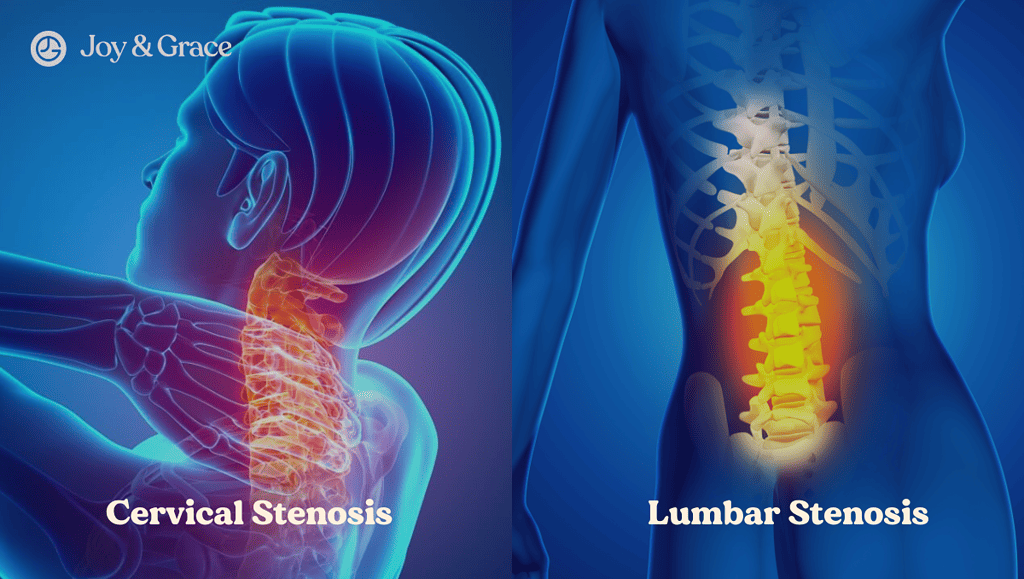
It would probably be a good idea to define some terms here, just so we can understand everything better.
Earlier, we said that spinal stenosis means tightening of the spinal spaces. Now, this tightening can (theoretically) happen anywhere along the spine. But in real life, it mostly occurs in just one of two places: the neck or the lower back. Stenosis of the spinal cord through the chest section (called thoracic spinal stenosis) is very rare.
Therefore, when you encounter the term “spinal stenosis,” it usually implies tightening of the spinal spaces in one of these two places. That’s why it’s a better idea to also mention the location of the tightening when we discuss spinal stenosis. Hence, spinal stenosis which occurs in the neck is called cervical spinal stenosis. When it occurs in the lower back, it is called lumbar spinal stenosis.
This distinction is important because cervical stenosis symptoms differ from lumbar stenosis.
In this article, we will talk about cervical spinal stenosis because it is this one (of the two) which is mostly associated with neck pain. To make reading easier, going forward, we will refer to cervical spinal stenosis simply as cervical stenosis. We will also use the word "stenosis" for narrowing.
Can Spinal Stenosis Happen In More Than One Area Of The Spine At The Same Time?
In the majority of cases, spinal stenosis usually refers to stenosis either in the neck or the lower back. However, very rarely, spinal stenosis can also happen in two areas simultaneously. A newer study with about 1000 patients found that about 11% of patients with neck and lower back pain have simultaneous cervical and lumbar spinal stenosis.
Does Spinal Stenosis Mean There’s Compression Of The Spinal Cord?
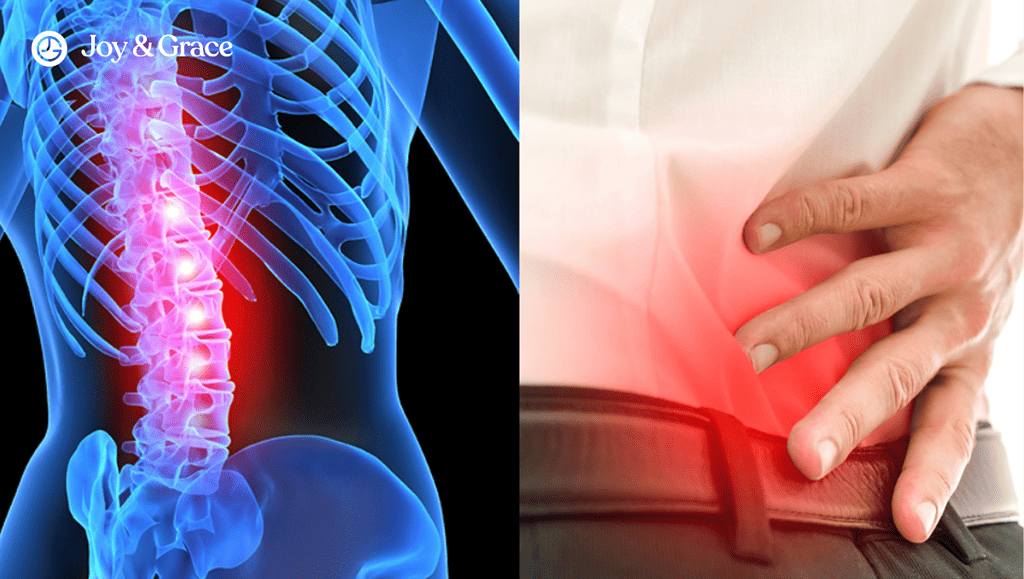
Spinal cord injuries can be quite dangerous; most of us know that. But luckily, spinal stenosis isn’t a disease that commonly compresses the spinal cord.
That’s because, most of the time, spinal stenosis is usually referred to as the tightening of the “sideways” openings (canals) of the vertebrae, where nerves exit from the spinal cord. There is no narrowing of the “central” opening, which is the spinal canal.
However, it is true that the spinal cord can also be affected in some patients. That happens when the stenosis is severe. When this occurs, a potentially dangerous condition called cervical myelopathy can arise. We will discuss cervical myelopathy later when we discuss the symptoms of cervical stenosis.
How The Spinal Cord Works And Its Relation With Cervical Stenosis And Neck Pain
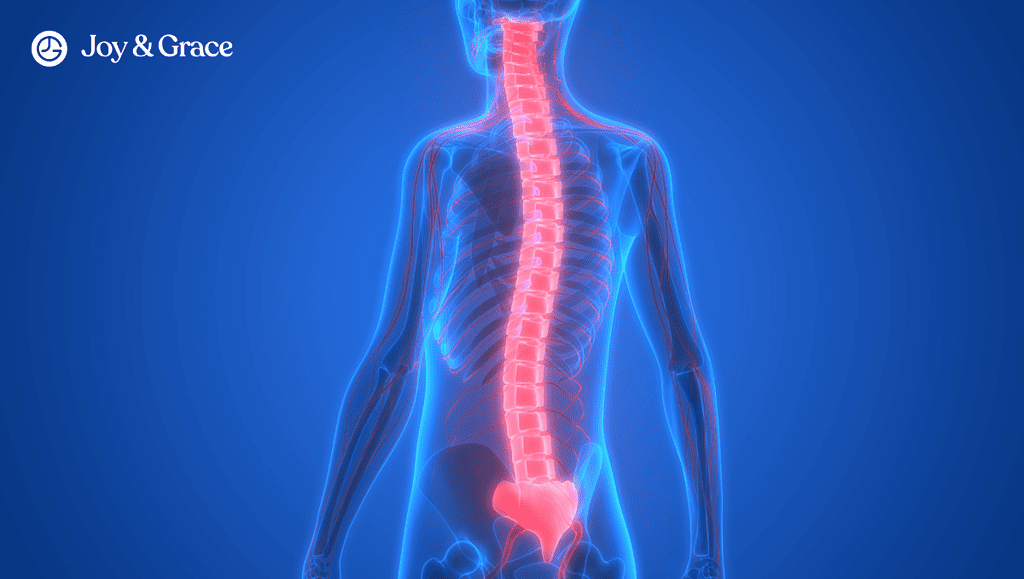
As you might be aware, the spinal cord is made of nerve fibers which spread to each part of the body. These nerve fibers originate from the brain. Some of these nerve fibers are motor fibers firing in the muscles. Some of them are sensory fibers enabling us to feel external stimuli. There are also pain fibers that allow us to feel pain. Autonomic nerves make our organs function properly without our control.
You can imagine the spinal cord being like a highway, which has off ramps that transition to larger streets, which brand off to neighborhood or side streets. So nerve fibers are the offramps which veer off from the major highway (spinal cord).
When these nerve fibers exit the spinal cord, they are referred to simply as nerves.
Now, the spinal cord is housed and protected by the vertebrae. The vertebrae are small bones that are stacked on top of each other. In this way, they form our spinal column, commonly known as our backbone. The vertebrae also possess a hole going in the middle of them. All the middle holes of the vertebrae being on top of each other leads to a canal being formed. This canal is called the spinal canal, and it is the space where the spinal cord passes.
But as we mentioned earlier, the vertebrae also form lateral (sideways) openings (canals) where nerve fibers leave. And in cervical stenosis, it is usually these lateral openings that get smaller and start compressing the local nerves, and in this way, symptoms such as neck pain arise.
This narrowing can happen for numerous reasons and in many ways, all of which we will explain below.
What Causes Cervical Spinal Stenosis?
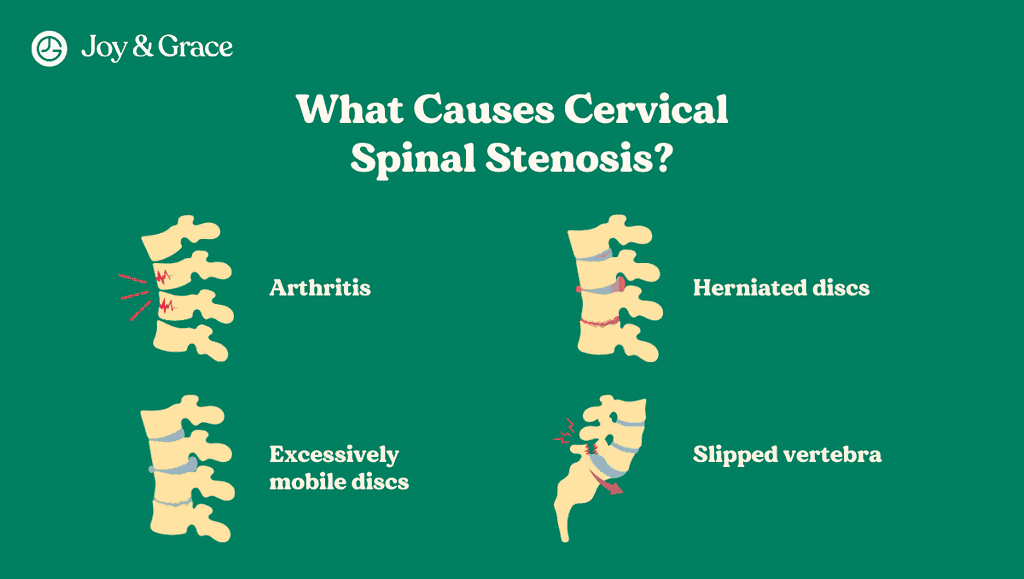
Cervical stenosis can result from a variety of reasons. Narrowing of the spaces can be brought on by injury, some diseases, inherited conditions, or aging and age-related changes in the spine.
Arthritis
Cervical stenosis can frequently be attributed to arthritis. Both osteoarthritis and rheumatoid arthritis have the potential to have an impact on the spine.
- Osteoarthritis (also known as spondylosis) is explained as a progressive degenerative disease. It affects all the cervical spine components. It is the most common cause of cervical stenosis. It is reported that up to 50% of people over 40 and up to 85% of people over 60 show some evidence of neck osteoarthritis in imaging studies. Although, not everyone shows cervical stenosis symptoms.
- Rheumatoid arthritis is a chronic systemic inflammatory disease. It primarily affects bones, synovial joints, and ligaments but can also involve nearly every organ system. Some studies suggest that up to 80% of rheumatoid arthritis patients show evidence of cervical spinal involvement in radiological findings.
Changes in the Spine Caused by Aging
The normal structure of the spine gradually deteriorates with age and age-related changes to the spine over time. The ligaments that hold the spine's vertebrae in place may thicken and calcify as people age, hardening from deposits of calcium. Joints and bones can also grow larger. Osteophytes is the term for the protrusions of a bone's surface that emerge from the body (bone spurs). For instance:
- The spinal cord or a nerve root may be pressed against by a herniated (bulging) disk. The disks, which resemble cushion-like pads and are located between the vertebrae. They serve as spacers and shock absorbers for the spine. The disk may dry out and crack with time, bulging as a result.
- The capsules (membranes) of the facet joints at the back of the vertebrae thicken when a spinal segment becomes excessively mobile. The segment's attempt to be stabilized may have resulted in bone spurs, which reduce the area around the nerve roots exiting the spinal cord.
- When one vertebra slides forward onto another vertebra, spondylolisthesis occurs. As a result, the spinal column is not properly aligned, and the spinal cord or nerve roots may be compressed.
Other Conditions
There are also other less common causes of cervical stenosis, such as:
- Ankylosing spondylitis, which is a chronic, inflammatory disease of the spine. It initially presents with lower back pain as opposed to neck pain, but cervical stenosis can occur some years after the diagnosis.
- Paget’s disease, which is a skeletal growth disorder in which abnormalities such as unusual bone growth can occur. However, the spine is affected in about 50% of patients with Paget’s disease. Out of this 50% of patients, the disease involves the neck in only 14% of cases.
- Trauma involving the neck has also been reported to cause cervical stenosis, especially after car accidents. Cases of cervical stenosis after sports injuries have also been documented. However, trauma involving the neck is still not a common cause of cervical stenosis. On the other hand, it is well known that injury to an already narrowed spinal canal could trigger the condition (disease) and its symptoms.
What Does Spinal Stenosis In The Neck Feel Like?
Cervical stenosis feels like a stiff and painful neck, which worsens when you stand up and gets better when you lie down. Other neck movements, such as bending the neck backward or to the side, may exacerbate the pain.
Additional symptoms, such as pain in the back of the ear or lower back part of the head, are less common.
What Are The Symptoms Of Stenosis In The Neck?

A stiff and painful neck is a universal symptom of cervical stenosis. But because many types of nerves are affected, symptoms are generally grouped as:
- Pain,
- Numbness if a sensory nerve has been compressed
- Weakness if a motor nerve has been compressed
- Loss of reflexes
- Burning or prickling sensation
Every area may be affected, including the neck, shoulder, arm, and all the way down to the thumb.
Although not common, there are reports that cervical stenosis can also cause chest pain. However, chest pain is usually not due to cervical stenosis and warrants immediate medical care.
The many different types of nerves passing through the spinal cord explain the large variety of symptoms.
Nerves that innervate the neck, shoulder, and arms exit from the spinal cord in the neck section of the spine. That means that cervical stenosis causes different types of symptoms based on which nerves have been compressed.
The mentioned symptoms can occur alone or in combination, depending on the nerves affected. Symptoms vary significantly between patients.
Knowing when the disease symptoms are starting to become severe is essential. As you might recall from earlier in the article, sometimes the stenosis can be so severe that it can compress the spinal cord as well.
What Is Cervical Myelopathy?
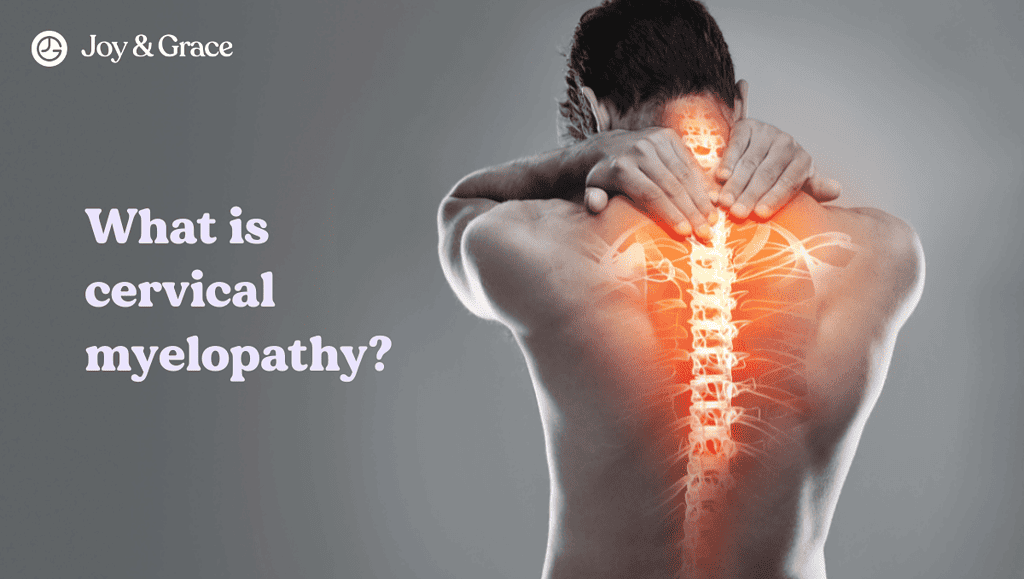
Also known as “cervical spondylotic myelopathy,” this disease happens when the stenosis is very severe and has started to compress the spinal cord in addition to the nerves exiting from it. It typically begins slowly before advancing step by step.
Patients who are not treated are at risk for developing substantial paralysis and functional loss.
In cervical myelopathy, there is a narrowing of the central spinal canal in addition to the “lateral” canals where the nerves exit.
Because the neck is a “transit” place of many nerve fibers of the spinal cord (which continue their path downwards), symptoms of compression of those nerve fibers also arise.
That explains why symptoms such as walking problems and bladder dysfunction are some of the symptoms of cervical myelopathy.
Symptoms of cervical myelopathy include symptoms of cervical stenosis in addition to:
- Clumsiness in the upper extremities
- Walking problems due to weakness in the lower extremity,
- Bladder dysfunction
- Bowel dysfunction
- General weakness
This condition warrants medical care as soon as possible.
Does Spinal Stenosis Hurt All The Time?
Depending on your activity, cervical stenosis may hurt all the time or only from time to time.
Strenuous activity that puts pressure on the neck may cause ongoing pain. But if you can rest for a few days, the pain might go away on its own.
Because cervical stenosis compresses the nerves, it causes an area of inflammation. Inflammation takes some time to go away, explaining why symptoms may come and go. But if the compression is severe, inflammation may be constant; hence the pain will be as well.
Can Spinal Stenosis Make You Feel Unwell?
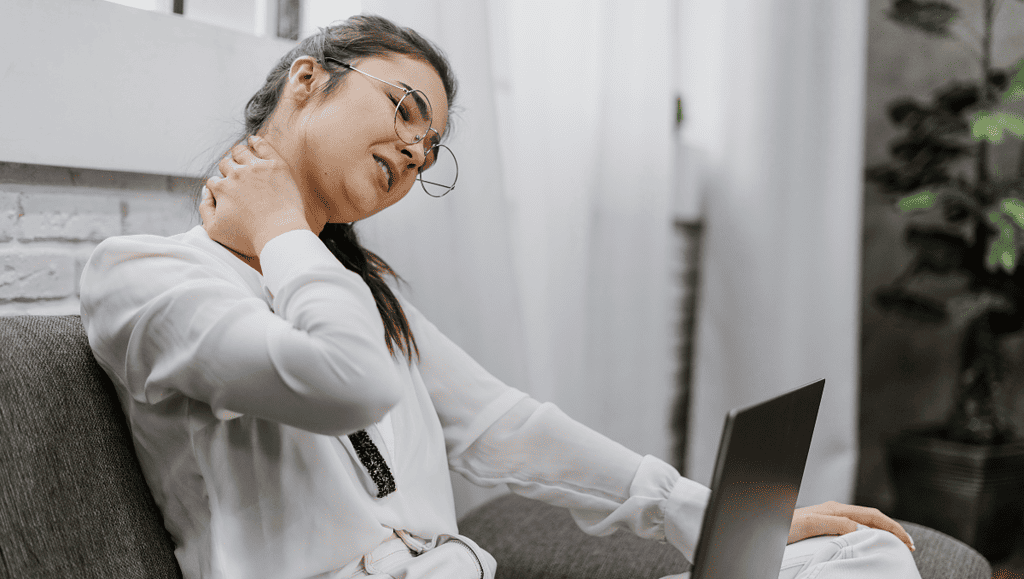
Cervical stenosis can definitely make you feel unwell, although not directly.
Chronic pain from severe stenosis might make you anxious and/or depressed, making you feel unwell. In fact, anxiety and depression are common in chronic neck pain patients. In a study with 80 chronic neck pain patients, more than 50% were diagnosed with anxiety and depression.
But alarming symptoms of feeling “unwell” must also be noted.
Symptoms such as consistent headaches, nausea, and vomiting are not normal in cervical stenosis.
What Is The Best Surgery For Spinal Stenosis?
The best surgery for cervical stenosis is the one that treats the cause of the disease best.
Although it must be mentioned that cervical stenosis most commonly occurs due to regular wear and tear of the vertebrae. In this case, a surgical operation called anterior cervical discectomy and fusion may be the best choice. It involves cutting a little part of the bad vertebrae and additional measures.
Other surgical options are also available if there is a different cause of the disease.
When Should You Have Surgery For Cervical Spinal Stenosis?
Doctors think all the below-mentioned criteria must be fulfilled in order for the surgery to be considered:
- Cervical stenosis symptoms and warning indicators (i.e., limb weakness, pain, or both)
- Evidence of cervical nerve root compression by imaging studies such as MRI or CT and
- Persistence of pain despite therapy for at least 6 to 12 weeks or progressive motor weakness that impairs function
What Are The Risks Of Surgery For Spinal Stenosis?
Although complications from surgery for cervical stenosis are rare, they can include:
- Esophageal perforation (less than 1% of cases),
- Failure of instrumentation (breakage or loosening of a screw or plate or nonunion, less than 5 percent),
- Nerve-root injury, recurrent nerve palsy, and injury to the spinal cord (occurring in 2–3% of cases after anterior cervical surgery).
How Do I Prepare For Spinal Stenosis Surgery?
Here’s how to prepare for surgery, and what to expect from it:
- Both neck discomfort and arm pain are common complaints of cervical stenosis. Be sure to go over the surgical objectives with your surgeon. Suppose you have both neck and arm pain. In that case, your chances of surgery resolving your arm pain are far higher than relieving your neck discomfort.
- Stop smoking. Any kind of nicotine can prevent bone fusion and healing. If you already smoke, you should quit smoking at least one month before surgery. You must also stop smoking cessation aids like gum or nicotine patches, as nicotine is the root of the issue regarding healing and bone fusion.
- Be aware of exercising and limitations after surgery. They may include limitations like bending, twisting, and lifting objects weighing more than 5 pounds.
- Make plans for a relative or friend to visit you at home and assist you during the first few weeks following surgery. Your need for assistance will depend on the type of surgery you have.
- Make plans to have someone pick you up after surgery and drop you off the morning of the procedure. When you’re being discharged after the operation, you won't be able to drive home.
- You'll receive a list of medications to avoid before surgery from your surgeon and the hospital staff.
- On the night of the operation, you shouldn't eat or drink anything after midnight.
- For your stay in the hospital, packing lightly is recommended. Bringing sneakers and loose-fitting clothing with an elastic waistband is a good idea.
What Happens After Spinal Surgery?
The surgery usually lasts 2 to 4 hours, and once finished, you'll be sent to a recovery room. Once stable, you will move to an orthopedic unit or the critical surgical care unit.
You'll receive painkillers through an IV right after surgery. Through the use of a PCA (Patient-Controlled Analgesia) pump, the IV drug will be administered. You can manage your medicine with this type of medication.
You will then receive oral painkillers soon after surgery, and the PCA will be withdrawn.
You won't be allowed to twist or bend after surgery. You will also be advised to avoid overextending your neck or bringing your chin to your chest.
After surgery, you might or might not need a brace, and the surgeon does the decision-making. Your surgeon will let you know if a brace is necessary.
Physical and occupational therapists will work with you the day following your surgery, helping you get back your stamina. They will give you tools such as a walker or cane to help with safe mobility and a device to assist in reaching to pick up objects off the floor. They will also teach you how to sit in a chair and get out of bed.
A physical therapist will also work with you once you start tolerating walking, getting out of bed, and sitting in a chair.
Some people may be discharged after one night in the hospital. However, some patients may need rehabilitation for some days before going home.
Before going home, you will receive instructions about pain, how to sleep (such as avoiding stomach sleeping), driving, sexual activity, etc.
How Long Is The Recovery Period After Spinal Stenosis Surgery?
The overall recovery period is usually 2 to 4 months. But after two to three weeks, you'll start to feel more like yourself, and things will improve over the following weeks.
How Painful Is The Recovery From Spinal Stenosis Surgery?
After surgery, mild to moderate neck pain can be expected for one to two weeks at the incision site and possibly radiating to the shoulder. For the first four weeks after surgery, some people also experience increased arm pain or numbness. This is due to inflammation and usually goes away on its own.
Some hospitals prescribe pain medications for up to 3 months after surgery, which is when you should not need them anymore.
When Can I Return To Work After Spinal Surgery?
A general time frame for returning to work after cervical stenosis surgery is 8 to 12 weeks. Although this depends on the type of work you do, you might be able to return earlier than that.
Is Spinal Stenosis Surgery Worth It?
Surgery may be worth it if you’ve received conservative treatment for 6 to 12 weeks and are still experiencing symptoms. Overall, difficulty with basic day-to-day activities suggests surgical treatment.
Studies suggest that 75% of patients who undergo cervical stenosis surgery in the neck report substantial symptom improvement (pain, numbness, and weakness) after just one month of the operation.
Still, not many studies are available comparing conservative treatment with surgery. That’s why the general treatment approach is attempting conservative treatment for as long as possible.
A detailed discussion with a specialized surgeon would be the best advice here.
Can Spinal Stenosis Heal On Its Own?
Unfortunately, cervical stenosis cannot heal on its own. However, symptoms may ease on their own, but you may need to visit a doctor to get the best treatment plan possible for this to happen.
Conservative treatment options include common measures such as:
- Avoiding activities that might provoke symptoms
- Non-narcotic painkillers
- Neck immobilization and
- Physical therapy
What Are The Final Stages Of Cervical Spinal Stenosis?
The final stages of cervical stenosis include symptoms that prevent your day-to-day activities. When you can't function properly, it severely decreases your overall well-being.
Cervical myelopathy, as we’ve discussed earlier, may also be thought of as a final stage of cervical stenosis. Because the spinal cord is also affected by this condition, symptoms below the neck and shoulder area also follow. That means there could be walking or bladder problems, occurring along with neck and shoulder weakness and loss of sensation at the same time.
How Serious Is Spinal Stenosis In The Neck?
Cervical stenosis is considered a progressive disease if left untreated, so it should be taken seriously. That doesn’t mean it will disable you completely, but symptoms may become more severe over time. That’s why it is so necessary for you to visit a doctor and discuss the best treatment plan.
On the other hand, cervical spondylotic myelopathy arising from cervical stenosis is dangerous. It prompts proper medical care as soon as possible.
How Can You Tell If Your Spinal Stenosis Is Getting Worse?
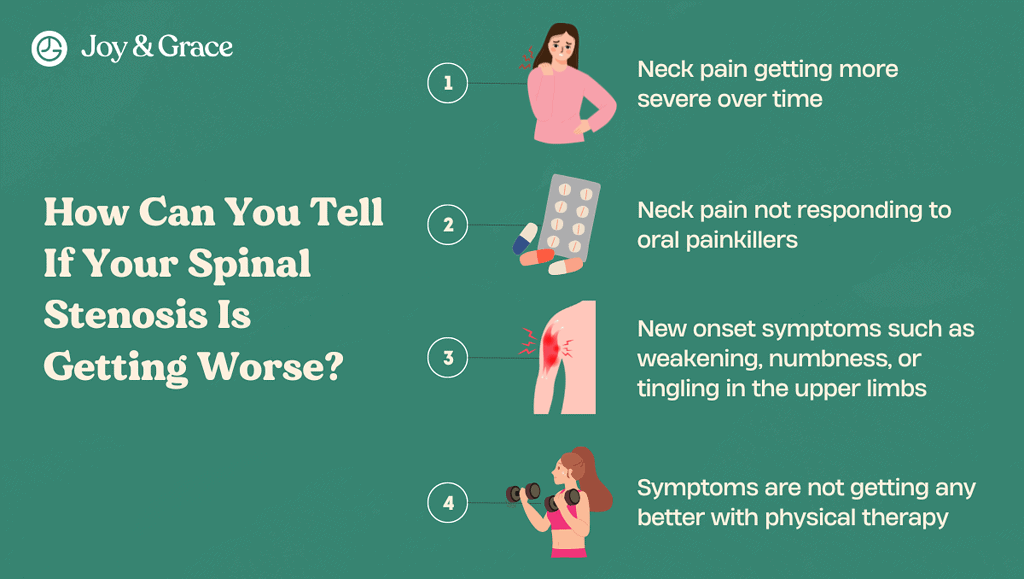
Symptoms that cervical stenosis is getting worse include:
- Neck pain getting more severe over time
- Neck pain not responding to oral painkillers
- New onset symptoms such as weakening, numbness, or tingling in the upper limbs
- Symptoms are not getting any better with physical therapy
Can Spinal Stenosis Affect Your Brain?
There are no studies that suggest that cervical stenosis affects your brain.
The fatigue from chronic pain may exhaust you and cause a loss of focus, but this is not due to the disease's direct impact on the brain.
Can You Be Paralyzed From Cervical Spinal Stenosis?
Because cervical stenosis usually worsens over a period of time and not quickly, complete paralysis is uncommon. However, muscle weakness could become severe and irreversible if the disease is neglected.
On the other hand, cervical myelopathy could cause permanent damage to the spinal cord. Because the spinal cord is compressed, it may cause significant paralysis and loss of function.
Thus, if you have symptoms of cervical stenosis and new problems such as walking or balance problems arise, this is a sign that you should visit a doctor immediately.
Takeaway
Neck pain that doesn't improve is a sign that you need to visit a doctor. Cervical stenosis is common in our age, but proper treatment is key to managing symptoms. Surgery might be a good option if conservative treatment fails; luckily, it works for most patients.









